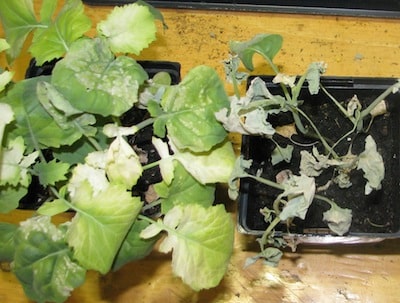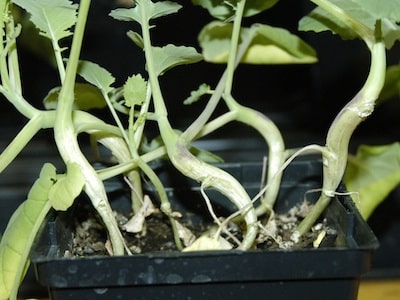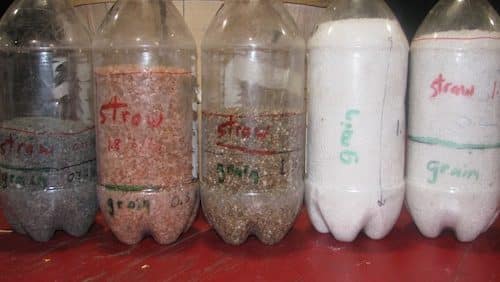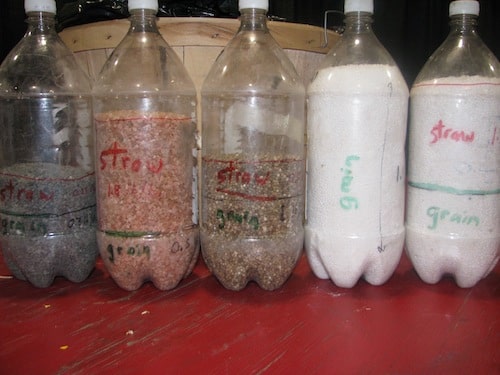Beneficials at work
CanoLAB in St. Albert featured a live — and gross — example of how wasp larvae hatching inside an alfalfa looper can kill the pest from the inside out. The video above, from ACPC, is an accelerated version of the process as it unfolded at CanoLAB.
N, P, K and S required to produce a bushel of canola
John Heard, crop fertility specialist at MAFRI, brought 2-litres bottles of fertilizer to show how much N, P, K and S it takes to produce a bushel of canola. (See the photo above.) As Heard’s bottles demonstrate, a bushel of canola requires 3.2 pounds of nitrogen (N), of which 1.9 pounds are removed in the grain and 1.3 pounds remain behind in the straw. (N is in the 2 white bottles on the right.) A bushel of canola requires 1.5 pounds of P2O5, of which 1.0 pound is removed with the grain and 0.5 is in the straw. (P is in the middle bottle.) A bushel of canola needs 2.3 pounds of potassium (K2O), of which 0.5 is in the grain and 1.8 pounds remain in the straw. (K is the pink fertilizer.) And a bushel of canola needs 0.55 pounds of sulphur (S), of which 0.3 is in the grain and 0.25 is in the straw. (S is the grey fertilizer.) Some of this required nutrient will come from soil and organic matter. The rest has to be supplied with fertilizer.
Herbicide carryover alert
Herbicide carryover may be higher than expected this spring after the long dry stretch from July through September last year. MAFRI oilseed specialist Anastasia Kubinec and MAFRI weeds specialist Nasir Shaikh, who demonstrated herbicide damage at their station in Brandon, emphasized that dry conditions can extend the period required for herbicide breakdown. Large amounts of snow melt will provide little other than to drive the residue deeper and dilute it through the profile. Nothing breaks down at temperatures below 4°C. Check your records and herbicide labels for carryover restrictions for canola. Contact representatives from herbicide companies if you have questions about carryover potential for residual products that would otherwise, under moist conditions, be approved for use the year ahead of canola.


Kubinec and Shaikh also talked about drift damage, and provided the following descriptions of typical damage from common groups:
Group 2 (Some products can be applied the year before canola. Some cannot. A dry fall can extend the breakdown period required for all group 2 products.): Foliar (drift) and soil applied (carryover) group-2 herbicides will cause stunted growth and yellowing, purpling and cupping of canola leaves for non-Clearfield canola.
Group 4 (2,4-D and MCPA): Canola stems twist, swell and crack. Undifferentiated callus tissue will build up around roots that may resemble clubroot symptoms.
Group 6 (bromoxynil): Canola leaves will show contact burns and yellowing, particularly toward the edges of leaves.
Group 9 (glyphosate): Canola plants wilt and yellow, beginning with the newest leaves.
Group 14 (CleanStart is approved for use ahead of canola. Heat and Authority are not approved for use ahead of canola and will cause damage.): Canola seeded into soils with Heat or Authority residue may germinate but not emerge.
Group 27 (Infinity): Canola leaves will become bleached.
Soil analysis can be done to test for certain residual herbicides. These tests do not indicate how much of the residue is available to the germinating plant. Bioassays (germinating the crop of interest in the soil of concern) are the best indicator of availability to the plant but still have a some uncertainty associated with them, and nobody offers those tests anymore. Look at last year’s herbicide records when making final rotation plans.
We will have more CanoLAB highlights next month after Saskatoon’s CanoLAB March 27-28, which is sold out. Those lucky enough to attend are encouraged to bring a camera. That way you can take your own photos of damaged plants for reference while scouting.


